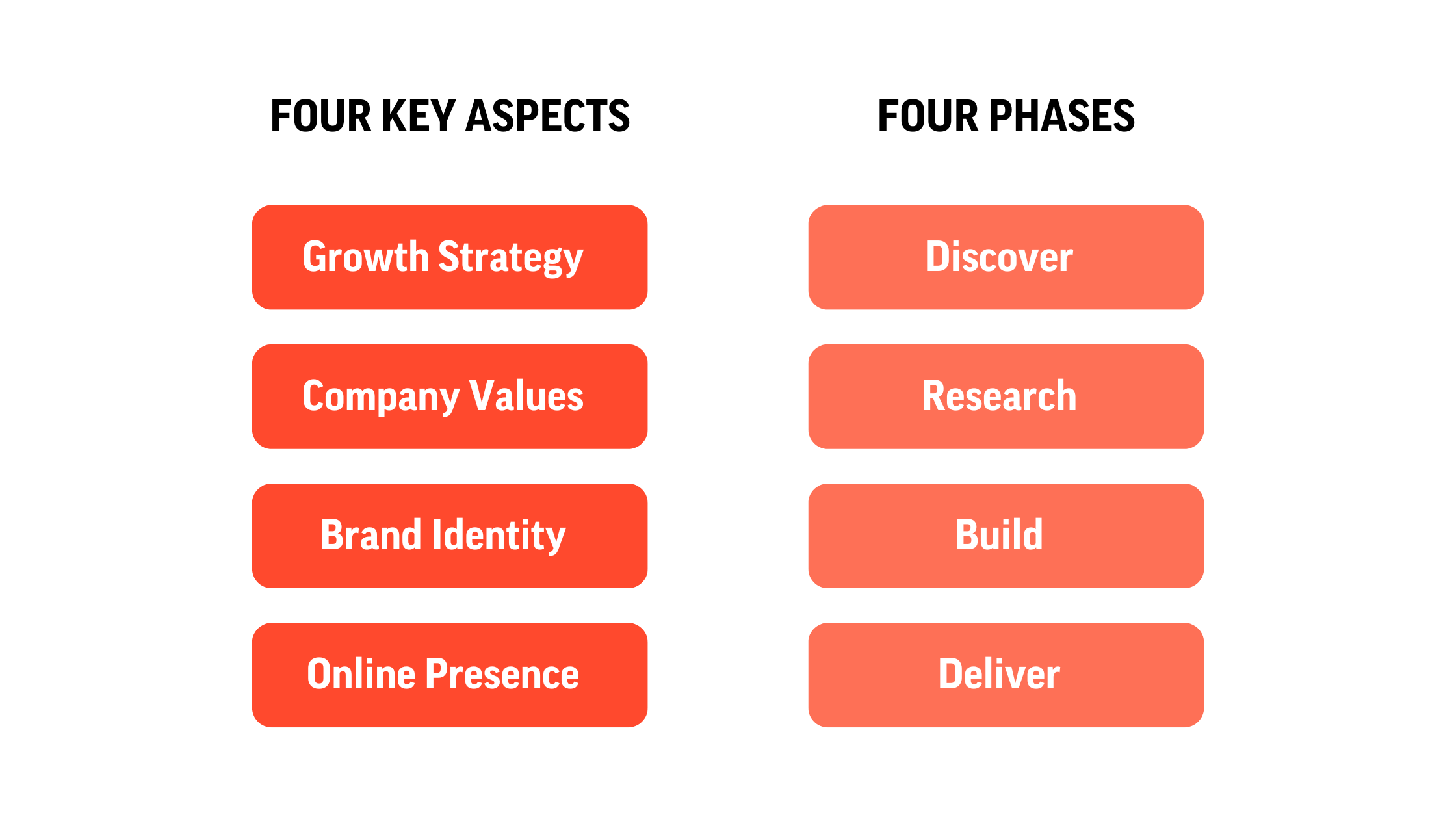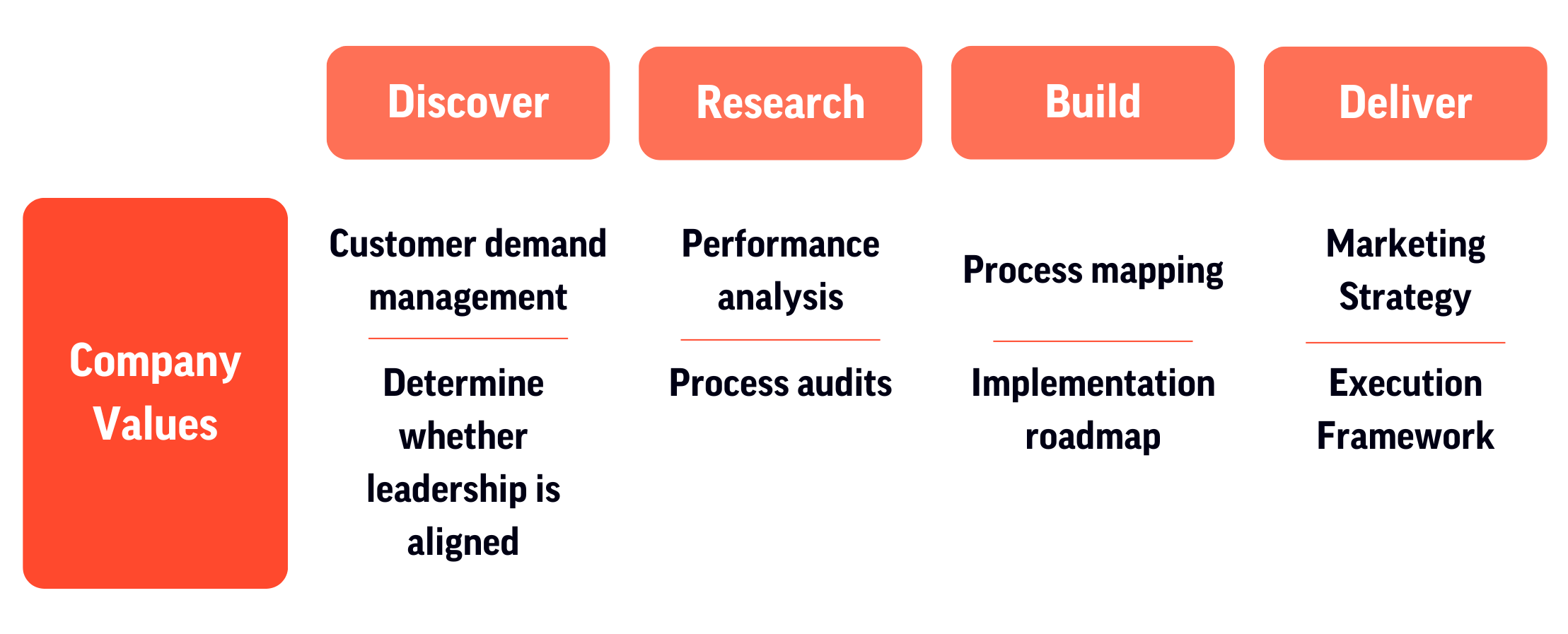What is a Growth Strategy Framework?

You need more than just a good sense of direction to grow your business. You need a comprehensive plan and the right tools to execute it—a growth strategy framework.
How to create a strong growth strategy framework
A growth strategy framework maps out each piece of your growth strategy to help you focus where (and when) it will do the most good.
A goal without a plan is just a wish. — Antoine de Saint-Exupéry
Your growth strategy framework creates a business ecosystem that aligns all aspects of your marketing efforts and converts more leads. A growth strategy framework has four key aspects and each aspect has four phases:
 1. The Growth Strategy aspect
1. The Growth Strategy aspect
Examples of the four phases of the Growth Strategy aspect:

Aspect #1 of your strategy framework is about your customers. Who are they and how do they interact with your brand? The answers to these questions might surprise you.
For example, in the 2010s, JCPenney unveiled a new pricing strategy called Fair and Square Every Day. Inspired by modern Apple stores, the company wanted to end coupon sales and offer everyday low prices instead.
But JCPenney’s everyday low prices were never as low as the biggest discounts they once offered. Their customers complained, boycotted, and turned to competitors to find the great deal and the satisfaction that comes with it—their key to customer satisfaction. Misunderstanding the customer’s hunger for the lowest price became very costly.
To avoid this issue, you want to practice a certain level of business transparency. And as part of your growth strategy framework, you should:
- Align your team through demand management,
- Conduct a process audit to determine whether your activities, resources, and behaviors are efficient and effective, and
- Create a transparent marketing strategy based on your aligned company values.
2. The Company Values aspect
Examples of the four phases of the Company Values aspect:

Company values can be implicit or explicit depending on company culture. Implicit values, however, often come with certain problems. For example, a common implicit value is that employees must always act in the best interest of the company. But not all employees interpret this value the same way.
To the CFO, acting in the company’s best interest might mean one’s actions should always boost profits, even in the short term. But to a team manager, improving team morale and job satisfaction—while requiring an investment—is the long-term answer to a profitable organization.
So, even though both believe they’re working for the company’s best interests, they’re pulling in different directions. This misalignment can cascade throughout an organization without anyone being aware of it.
This example deals with internal company values, but it applies to external values too. For instance, if management doesn't agree on or are unclear about the value of their product to customers, Marketing can’t even identify the target audience, much less pitch to them.
To avoid this issue, you want to practice a certain level of business transparency. And as part of your growth strategy framework, you should.
- Align your team through demand management,
- Conduct a process audit to determine whether your activities, resources, and behaviors are efficient and effective, and
- Create a transparent marketing strategy based on your aligned company values.
3. The Brand Identity aspect
Examples of the four phases of the Brand Identity aspect:

Your brand is more than a logo. It’s a combination of the products and services you offer, how you promote them, what colors you dress them in, and the tone of voice used to present them to the public.
Apple’s brand identity includes intuitive products, sophisticated colors, and minimalistic but beautiful designs and packaging. Theirs is a highly visual brand identity.
To build a strong brand identity:
- Research strong brand identities for inspiration
- Conduct internal interviews to determine how your company sees itself
- Create a visual style guide for marketing consistency
- Craft a hero message
4. The Online Presence aspect
Examples of the four phases of the Online Presence aspect:

No matter who your target audience is, they’re online, and possibly already searching for your company’s offerings. Naturally, you want them to be able to find you. This might include a social media presence, but first you need to optimize your website.
Once a potential customer reaches your website, easy navigation is essential. No one has time to hunt for clues; invest in the best for your online presence.
To build a strong online presence:
- Conduct content and SEO audits to determine how your website is currently performing
- Partner with a web designer to create a streamlined, user-friendly site that communicates professionalism and trust
Grow your business strategically and sustainably
Put a solid framework under your plans to grow your business. Growth strategy, company values, brand identity, and online presence create a firm foundation for expanding your organization. A growth plan this organic is also more sustainable than trying to keep your team at a fever pitch. With a great plan, even daily tasks move your organization incrementally closer to the goal. Elaborate your growth plan today with DecideAct specialist’s support.










